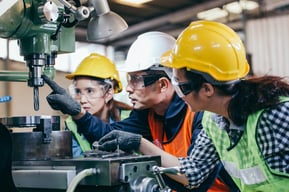
Every industry needs to consider fire and life safety, but when it comes to manufacturing facilities, special considerations are often required. Plants can use heavy machinery, chemicals and more that can increase the risk for fires or electrical issues.
According to the National Fire Protection Association (NFPA), fire departments responded to an average of almost 38,000 fires on industrial or manufacturing properties between 2011 and 2015, the latest years for which there is data. These fires led to an average of 16 civilian deaths, 273 civilian injuries and $1.2 billion in direct property damage.
To protect your people and your property, those in the manufacturing field need to take special care when it comes to fire and life safety. Below, find some notes that every industrial property manager needs to consider when planning for fire and life safety emergencies.
Stay up on your system maintenance
The best line of defense in protecting your facility from fire is to have an adequate fire and life safety system – from proper alarms, smoke detectors and emergency lighting, to functioning fire sprinklers, fire suppression systems, extinguishers and more.
Your best bet is to work with a preferred fire protection and life safety company like CertaSite when installing or maintaining your system. OSHA and the NFPA have required inspection schedules for all fire and life safety equipment, and at CertaSite, we can manage that process for you to ensure you stay compliant and as protected as possible. At the minimum, most systems require full testing at least once a year, while fire extinguishers and smoke detectors should be checked monthly.
There are also regulations around the storage and placement of chemicals, dictated by OSHA and the NFPA. CertaSite professionals can help ensure compliance in these areas as well.
Consider specialized systems
Unlike most workplaces, industrial properties often have valuable heavy machinery and even chemicals that are used to create various goods. Conditions like this require specialized systems when it comes to fire safety.
If a fire breaks out, you of course want to above all protect your people and put the fire out as quickly as possible, but you may also want to protect expensive equipment. Luckily, there are a wide range of fire suppression systems – including water, CO2 and dry chemical systems – that work best in various situations with different needs.
Fire and life safety professionals can help determine the best systems for the facility, even if different systems are needed in different spots. If a fire breaks out, the entire system will work together to protect your people and property the best it can.
Every industrial property will have different needs. Because of this, a one-size-fits-all approach to fire and life safety systems isn’t going to work – each facility likely needs a custom solution, depending on what is manufactured and what equipment or chemicals are present.
Have an evacuation plan & train your employees
Finally, it’s essential that all employees in an industrial plant or manufacturing facility understand the evacuation plan and fire safety protocols, as well as have adequate training in using fire extinguishers or other personal protective equipment (PPE).
Formal training should be done for all new employees, and at least annually for every year after that. Fire drills should be practiced at least twice a year, but ideally quarterly or even more frequently. Additionally, signage with directions toward various exits should be posted throughout the facility for reference by employees.
Exits should all be adequately marked with emergency lighting, and all employees should know the procedures to follow if a fire does break out. With proper knowledge, training and practice, everyone will know exactly what to do in case of emergency.
Fire and life safety can be an overwhelming topic. At CertaSite, we’re here to simplify the process by walking you through it step-by-step. From selecting a system and the actual installation, to keeping up on maintenance and making sure you’re always protected, we are here to help. We can also provide onsite training when it comes to fire extinguishers, how to check emergency and exit lights, and more.

